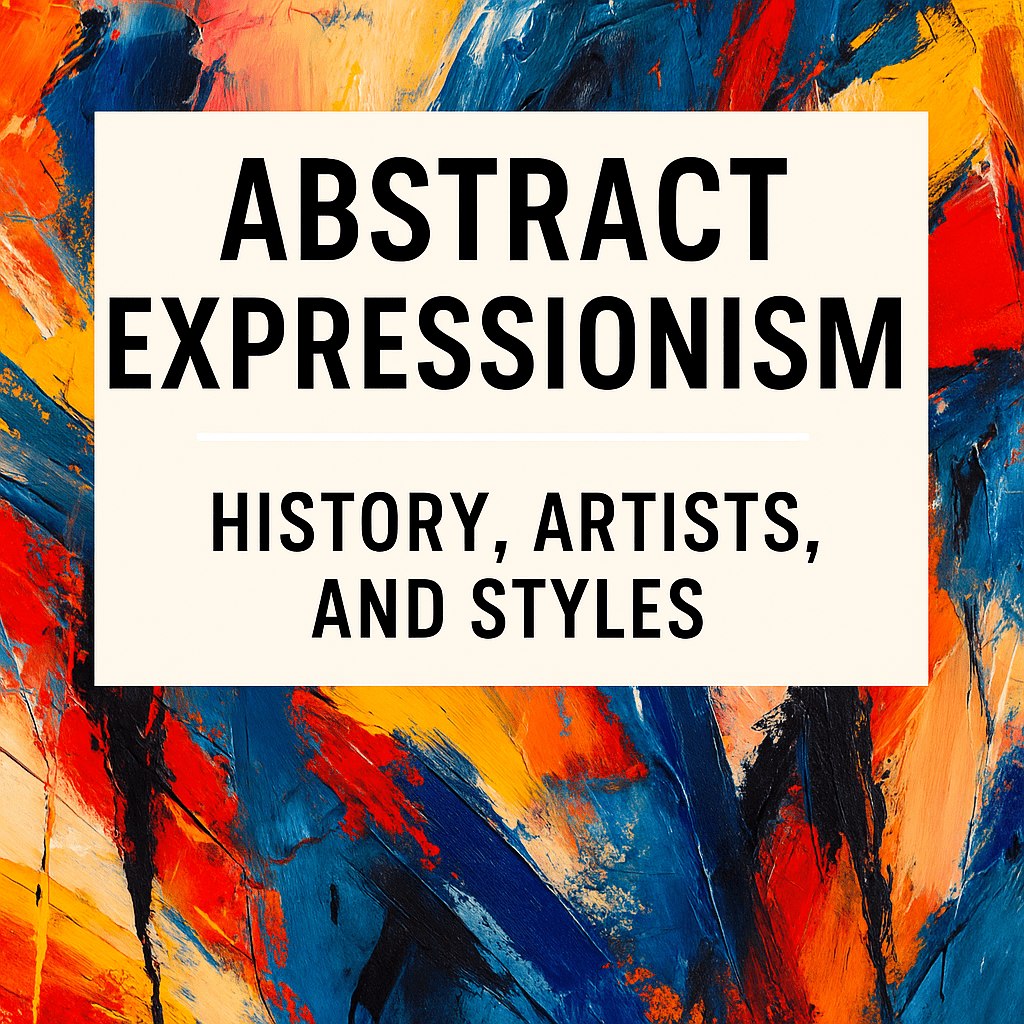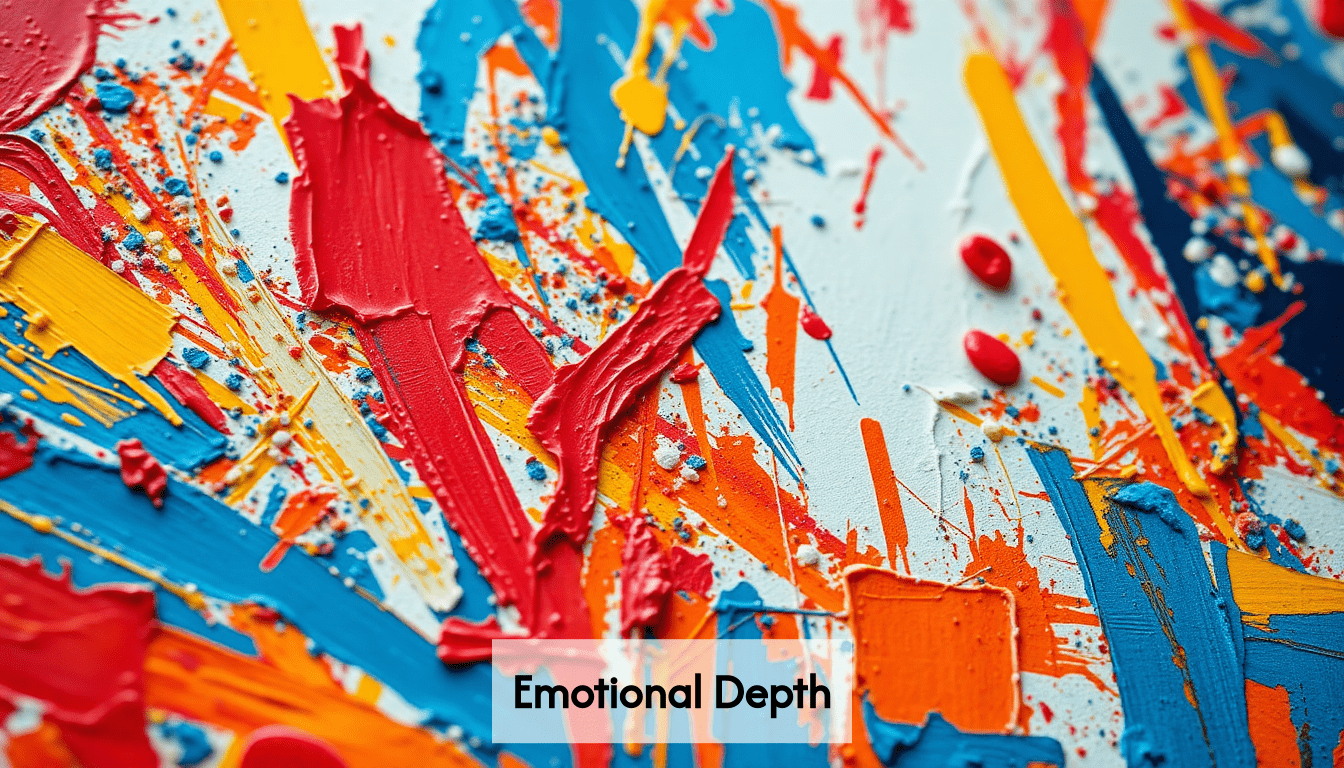Abstract Expressionism: Characteristics of Abstract Art
Abstract Expressionism is an art movement that emerged in the mid-20th century, primarily in New York City, and it marked a significant departure from traditional art forms. This dynamic and highly abstract art style revolutionized the art scene by focusing on spontaneity, emotion, and the exploration of abstract forms. As an influential movement, it paved the way for modern art and continues to inspire contemporary art today. In this article, we will explore the key characteristics of Abstract Expressionism, the major artists who shaped the movement, and its lasting impact on the art world.
What are the Key Characteristics of Abstract Expressionism?
How Do Abstract Expressionist Artists Convey Emotion?
Abstract Expressionist artists convey emotion through their dynamic use of color, form, and technique. Unlike traditional representational art, where subjects and themes are more explicit, Abstract Expressionism invites viewers to interpret the emotions embedded in the artwork. The characteristics of Abstract Expressionism include bold brushstrokes, gestural application of paint, and an emphasis on the artist's emotional state during the creation process. Through these methods, artists often express deep personal feelings and universal human experiences, making each painting a unique work of art that resonates on an emotional level.
What Role Does Spontaneity Play in Abstract Art?
Spontaneity is a hallmark of Abstract Expressionism and is central to its creative process. Many abstract expressionist artists embraced the idea of creating art without premeditated plans, allowing their instincts to guide them. This approach led to a sense of immediacy and authenticity in their work, capturing the rawness of human emotion and the unpredictability of life. The spontaneity in abstract expressionist paintings is often evident in the fluidity of the paint and the energetic application of color, which creates a dynamic visual experience for the viewer.
How is Color Used in Abstract Expressionism?
Color plays a crucial role in Abstract Expressionism, serving as a powerful tool for conveying emotion and meaning. Abstract expressionist artists use vibrant and contrasting colors to evoke specific feelings, challenge perceptions, and create tension within the artwork. The characteristics of abstract expressionist paintings often include a bold palette, with colors applied in layers or in sweeping gestures. This use of color not only adds depth and movement to the artwork but also allows viewers to engage with the piece on a sensory level, interpreting the hues and tones in their own way.
Who are the Major Abstract Expressionism Artists?
What Impact Did Willem de Kooning Have on the Movement?
Willem de Kooning was a pivotal figure in the Abstract Expressionist movement, known for his innovative approach to form and structure. His work often blurred the lines between abstraction and figuration, creating a unique style that challenged traditional notions of art. De Kooning's abstract expressionist style was characterized by vigorous brushwork and complex compositions, which captured the energy and chaos of modern life. His contributions significantly shaped the development of Abstract Expressionism, influencing many abstract expressionist artists who followed in his footsteps.
How Did Other Key Artists Influence Abstract Expressionism?
In addition to Willem de Kooning, other key artists played critical roles in the evolution of Abstract Expressionism. Artists like Jackson Pollock and Mark Rothko made significant contributions through their innovative techniques and visionary approaches. Pollock's famous "drip" paintings exemplified the spontaneous and gestural nature of the movement, while Rothko's color field paintings explored the emotional impact of color on a grand scale. Together, these artists expanded the boundaries of what art could be, paving the way for future generations of abstract painters and influencing the course of modern art.
Which Artists are Considered Pioneers of the Style?
Several artists are considered pioneers of Abstract Expressionism, each bringing their unique perspectives and techniques to the movement. In addition to de Kooning, Pollock, and Rothko, artists such as Franz Kline, Barnett Newman, and Clyfford Still were instrumental in defining the characteristics of abstract expressionism. These pioneers embraced the freedom and experimentation that Abstract Expressionism allowed, creating artworks that challenged conventional art styles and inspired countless artists worldwide. Their legacy is evident in the many abstract expressionist works that continue to captivate audiences in galleries and museums, such as the Museum of Modern Art in New York.
How Did Abstract Expressionism Influence Contemporary Art?
In What Ways Did Abstract Expressionism Shape Modern Art?
Abstract Expressionism had a profound impact on the development of modern art, ushering in new ideas about the role of the artist and the nature of art itself. By emphasizing emotion, spontaneity, and abstraction, the movement challenged the existing art scene and laid the groundwork for subsequent art movements, including Pop Art and Minimalism. Abstract Expressionism encouraged artists to explore new techniques and materials, pushing the boundaries of artistic expression and influencing a wide range of contemporary art practices.
What Elements of Abstract Expressionism are Seen in Contemporary Art?
Many elements of Abstract Expressionism are evident in contemporary art, as artists continue to draw inspiration from the movement's emphasis on emotion and abstraction. The characteristics of abstract art, such as bold color choices, dynamic compositions, and gestural techniques, are frequently seen in contemporary artworks. Additionally, the movement's focus on the artist's personal expression and the viewer's interpretation remains a central theme in modern art, encouraging artists to create abstract works that are both personal and universally resonant.
How Have Artists Like Jackson Pollock Impacted Art History?
Artists like Jackson Pollock have left an indelible mark on art history, transforming the way we perceive and create art. Pollock's innovative approach to painting, which involved dripping and splattering paint onto large canvases, revolutionized the art world and redefined the possibilities of abstract art. His contributions helped to establish Abstract Expressionism as a dominant force in post-war American art, and his influence can still be seen in the works of contemporary artists who continue to explore the boundaries of abstraction and expression.
What are the Characteristics of Abstract Art?
How Do Abstract Works Differ from Other Art Styles?
Abstract works differ from other art styles in that they do not attempt to represent reality in a literal way. Instead, abstract art focuses on conveying emotions, ideas, and concepts through the use of color, form, and line. Unlike representational art, which depicts recognizable subjects, abstract art often relies on abstraction to evoke a sensory or emotional response from the viewer. This approach allows artists to explore the essence of their subject matter, creating works of art that are open to interpretation and capable of eliciting a wide range of emotional reactions.
What Makes Abstract Art Unique in the Art Scene?
Abstract art is unique in the art scene for its ability to transcend traditional boundaries and challenge the viewer's perception of reality. The characteristics of abstract art, such as its emphasis on color, form, and emotion, set it apart from other art styles and allow for a high degree of creative freedom. Abstract artists often use unconventional techniques and materials, resulting in highly abstract works that defy categorization and invite viewers to engage with the artwork on a deeper level. This sense of innovation and experimentation continues to make abstract art a vital and dynamic part of the contemporary art world.
How Do Artists Often Express Themselves Through Abstract Paintings?
Artists often express themselves through abstract paintings by using color, form, and technique to convey their emotions and ideas. The abstract expressionist movement encouraged artists to explore their inner worlds and translate their feelings onto the canvas, resulting in works that are deeply personal and evocative. Through abstract art, artists can communicate complex emotions and concepts that may be difficult to express through words or representational imagery. This ability to capture the intangible and transform it into a visual experience is one of the defining characteristics of abstract art.
What is the Legacy of the Abstract Expressionism Art Movement?
How Did Abstract Expressionism Change the Art World?
Abstract Expressionism changed the art world by redefining the role of the artist and the purpose of art. The movement shifted the focus from traditional representation to personal expression, encouraging artists to explore new techniques and push the boundaries of creativity. This transformation led to a greater acceptance of abstract and non-representational art forms, paving the way for future art movements and expanding the possibilities of artistic expression. Abstract Expressionism's legacy is evident in the continued evolution of modern art and the enduring influence of its pioneering artists.
What Lasting Effects Has the Movement Had on Art and Culture?
The lasting effects of Abstract Expressionism on art and culture are profound, influencing not only the visual arts but also literature, music, and philosophy. The movement's emphasis on emotion and individuality resonated with other cultural movements of the time, inspiring a new generation of artists and thinkers. Abstract Expressionism also played a crucial role in establishing New York City as a major center of the international art scene, shifting the focus from Europe to America and contributing to the development of American art as a dominant force in the global art world.
How Do Artworks and Artists from the Movement Continue to Inspire?
Artworks and artists from the Abstract Expressionism movement continue to inspire contemporary artists and audiences with their bold experimentation and emotional depth. The movement's pioneering spirit and commitment to artistic freedom resonate with those who seek to challenge conventions and explore new creative possibilities. Many abstract expressionist works remain influential today, serving as powerful reminders of the transformative power of art and the enduring impact of the Abstract Expressionist movement on the art world and beyond.
Enhance Your Space with Unique Modern Masterpieces
Are you inspired by the innovative mediums and conceptual depth highlighted in our exploration of contemporary art? You’re not alone! Today’s art enthusiasts are seeking cultural relevance and emotional connections in their artwork. However, finding pieces that resonate with modern themes and fit your unique style can be a challenge. That’s where we come in!
At Rossetti Art, we specialize in canvas prints, original paintings, and modern sculptures that celebrate the spirit of now. Each piece created by Chiara Rossetti brings a personal touch that connects deeply with current social narratives—just like the modern masterpieces discussed in the article. Don’t miss out on the chance to elevate your home decor with breathtaking artwork that speaks to your values and aesthetic. Explore our collection today and find your perfect piece! Act now, and transform your space into a gallery of inspiration!
FAQ
Q: What is Abstract Expressionism and how did it emerge?
A: Abstract Expressionism is an art movement that emerged in the 1940s and 1950s, primarily in New York. It is characterized by the use of color and abstract forms to convey emotions and ideas. It marked a shift where a generation of American artists began to dominate the international art scene, moving away from European influences.
Q: Which artists are associated with Abstract Expressionism?
A: Artists associated with Abstract Expressionism include Jackson Pollock, Mark Rothko, Willem de Kooning, and Lee Krasner, among others. Many artists in this movement were committed to art as expressions of their inner thoughts and emotions.
Q: How did the New York art scene contribute to the rise of Abstract Expressionism?
A: The New York art scene became a hub for avant-garde art during the mid-20th century, providing a fertile ground for the rise of Abstract Expressionism. The city attracted many artists and intellectuals, creating an environment where new ideas and styles could flourish.
Q: What are some characteristics of Abstract Expressionist artworks?
A: Abstract Expressionist artworks often feature bold, dynamic brushstrokes, fields of color and abstract forms, and a focus on the process of creation itself. These works aim to express the artist's subconscious and emotional states directly on the canvas.
Q: How did European artists influence Abstract Expressionism?
A: Although Abstract Expressionism is primarily an American movement, many European artists who fled to the United States during World War II brought with them avant-garde ideas that influenced American painters. This fusion helped shape the unique characteristics of Abstract Expressionist art.
Q: What role did female artists play in Abstract Expressionism?
A: Female artists like Lee Krasner and Helen Frankenthaler made significant contributions to Abstract Expressionism. They were part of the movement's development and challenged the male-dominated art world by producing powerful abstract works.
Q: How does Abstract Expressionism impact art and the viewer?
A: Abstract Expressionism impacts art and the viewer by emphasizing personal expression and emotional depth. The artworks encourage viewers to engage with the piece on a personal level, interpreting its meaning based on their own perceptions and emotions.
Q: What techniques are commonly used by abstract painters in New York?
A: Abstract painters in New York often employed techniques such as action painting, characterized by spontaneous and vigorous brushwork, and color field painting, which focused on large areas of a single color or simple compositions to evoke emotion.
Q: How did the impact of Abstract Expressionism extend beyond the art world?
A: The impact of Abstract Expressionism extended beyond the art world by influencing other forms of creative expression, such as literature and music. The movement's emphasis on individuality and emotion resonated with broader cultural and social movements during its time.




Leave a comment
This site is protected by hCaptcha and the hCaptcha Privacy Policy and Terms of Service apply.